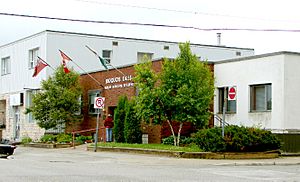Iroquois Falls facts for kids
Quick facts for kids
Iroquois Falls
|
|
|---|---|
|
Town
|
|

Iroquois Falls municipal office
|
|
| Country | |
| Province | |
| District | Cochrane |
| Established | 1912 |
| Incorporated | 1915 |
| Government | |
| • Type | Town |
| Area | |
| • Land | 599.43 km2 (231.44 sq mi) |
| Population
(2006)
|
|
| • Total | 4,729 |
| • Density | 7.9/km2 (20/sq mi) |
| Time zone | UTC-5 (EST) |
| • Summer (DST) | UTC-4 (EDT) |
| Postal code span |
P0K
|
| Area code(s) | 705 |
| Website | Town of Iroquois Falls |
Iroquois Falls is a town located in Northern Ontario, Canada. In 2011, about 4,595 people lived there.
The town center is about 11 kilometers east of Ontario Highway 11. It sits right on the banks of the Abitibi River, which is west of Lake Abitibi. Timmins, a much larger city in northern Ontario, is about 70 kilometers southwest. Other small communities like Monteith, Nellie Lake, and Porquis Junction are also part of Iroquois Falls.
For many years, the main business in Iroquois Falls was a big mill. This mill made newsprint and other printing papers. However, in December 2014, the company that owned it, Resolute Forest Products, announced it would close forever. Luckily, there are also three hydro-electric dams nearby that produce power. The Monteith Correctional Complex, a provincial prison, is located in the community of Monteith.
Contents
History of Iroquois Falls
Iroquois Falls was first built as a "company town." This means it was created by a company for its workers. The owner of the Abitibi Power and Paper Company, Frank Harris Anson, started building it. He wanted to create a very special town.
Designing the Town
Anson was inspired by the "garden city movement." This idea focused on planning towns with lots of green spaces. In 1913, a Chicago architecture firm was hired to design the town. They planned the streets, parks, and houses.
The town's parks and shops were kept separate from the paper mill. The streets were curved and focused on the town's center. A large church was built, which was the first English Catholic Parish in Northern Ontario. It is still an important landmark today.
Life in the Company Town
Anson's company town had everything its residents needed. There was a hospital, a school, and a hotel for company guests. The homes for employees were designed to look like old farmhouses. Their size and location showed how important the employee was at the mill. For example, papermakers lived in connected homes. Senior managers lived in bigger, single-family homes on different streets.
Growth and Challenges
In 1916, a big fire destroyed much of the town. But Anson kept working to make the town beautiful as it was rebuilt. This unique style earned the town the nickname "Anson's Folly." The paper mill brought many people to the area looking for work. The creation of the Temiskaming and Northern Ontario Railway also helped the town grow. This railway was very important because there were not many roads back then.
Images for kids








